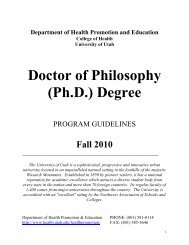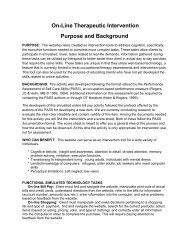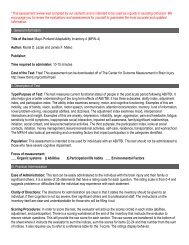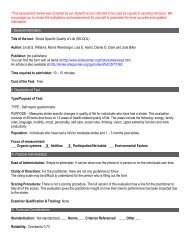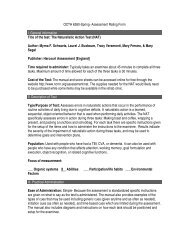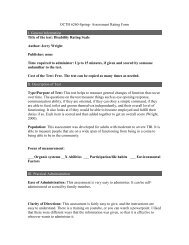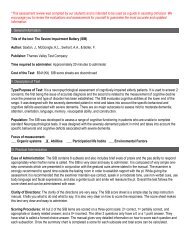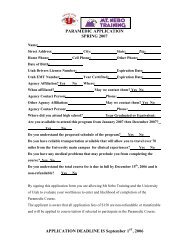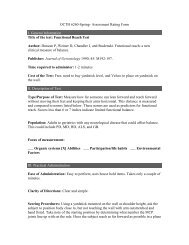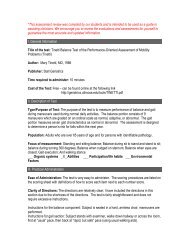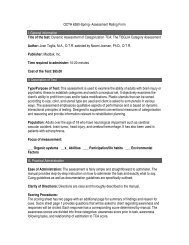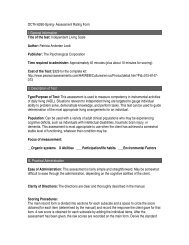Revisiting speech rate and utterance length ... - ResearchGate
Revisiting speech rate and utterance length ... - ResearchGate
Revisiting speech rate and utterance length ... - ResearchGate
You also want an ePaper? Increase the reach of your titles
YUMPU automatically turns print PDFs into web optimized ePapers that Google loves.
3. ResultsM. Blomgren, A.M. Goberman / Journal of Communication Disorders 41 (2008) 159–178 1673.1. Controlled speaking tasks3.1.1. Non-stuttering speakersThe 22 normally fluent speakers exhibited no disfluency (stuttering or otherwise) in anyof the four experimental speaking tasks. Thus, the group mean disfluencies were 0.0% foreach of the four tasks. Therefore, <strong>speech</strong> fluency for the control participants was withinnormal limits. These findings clearly indicate that even the alternating <strong>rate</strong> tasks wererelatively easy for these individuals <strong>and</strong> did not result in any <strong>speech</strong> motor breakdown.3.1.2. Stuttering speakersOverall, the mean percentage of words stuttered by the 22 stuttering speakers across thefour tasks was 12.0% (S.D. = 12.8%). This mean percentage of stuttered words across thefour controlled speaking tasks was remarkably close to the mean percentage of stutteredwords on the spontaneous speaking task (12.3%). The mean percentage of stuttered wordson the single words – habitual <strong>rate</strong> task was 5.5% (S.D. = 8.9%), the single words – variable<strong>rate</strong> task was 11.0% (S.D. = 9.0%), the initial words of the phrases – habitual <strong>rate</strong> task was13.5% (S.D. = 14.1%), <strong>and</strong> the initial words of the phrases – variable <strong>rate</strong> task was 18.1%(S.D. = 14.4%).A r<strong>and</strong>omized-blocks two factor ANOVA with repeated measures on both factors wasperformed on the group data to determine whether significant differences existed among thefour tasks with respect to the independent variables of <strong>length</strong> of <strong>utterance</strong> <strong>and</strong> speaking <strong>rate</strong>.In order to stabilize the inherent variance in percentage type data, the percentage of stutteredwords was transformed to arc-sine values before statistical comparisons were conducted.Length of <strong>utterance</strong> was the first repeated independent variable (with two levels: words <strong>and</strong>phrases), <strong>and</strong> speaking <strong>rate</strong> was the second repeated independent variable (with two levels:stable <strong>and</strong> variable). The analysis indicated no interaction between <strong>length</strong> of <strong>utterance</strong> <strong>and</strong>speaking <strong>rate</strong> [F(1, 21) = 2.45, p = 0.13]. An ANOVA interaction plot is provided in Fig. 2.Significant main effects were identified for <strong>length</strong> of <strong>utterance</strong> [F(1, 21) = 20.91, p = 0.0002]<strong>and</strong> for <strong>speech</strong> <strong>rate</strong> complexity [F(1, 21) = 17.11, p = 0.0005]. Participants demonst<strong>rate</strong>dsignificantly more stuttering on the first word of the phrases compared to single words, <strong>and</strong>more stuttering in the variable <strong>rate</strong> tasks compared to the stable <strong>rate</strong> tasks.3.2. Performance according to severity levelIn order to evaluate participant performance according to severity of stuttering, twostuttering severity groups were identified from the original 22 participants. A median splitwas conducted <strong>and</strong> a ‘‘less severe group’’ was established using the 11 participants with thelowest percent of stuttering on the spontaneous speaking task (lower half). A ‘‘more severegroup’’ was established using the 11 participants with the highest percent of stuttering onthe spontaneous speaking task (upper half). It is acknowledged that this median splitmethod is somewhat arbitrary, but it does provide maximal power to examine severityeffects within the data. The spontaneous speaking task was used to sepa<strong>rate</strong> the groupsbecause it involved a natural context <strong>and</strong> was also closely matched to the four experimental



